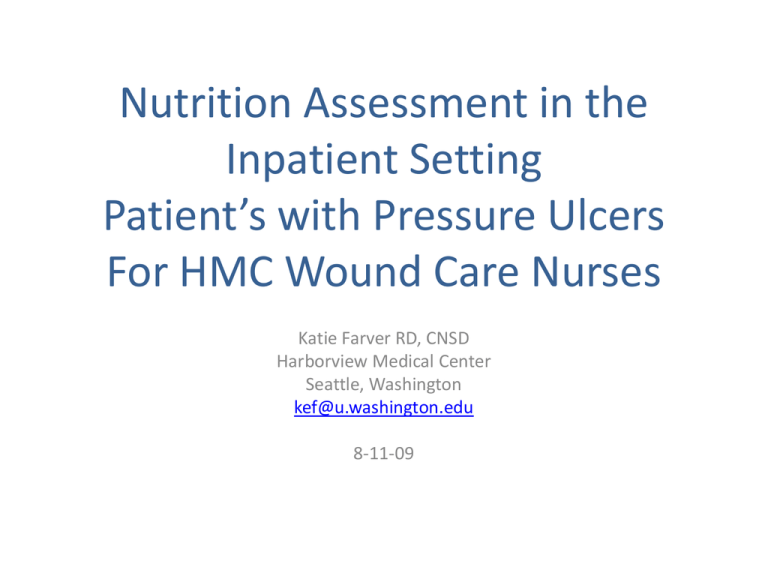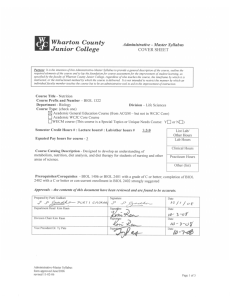Nutrition Assessment
advertisement

Nutrition Assessment in the Inpatient Setting Patient’s with Pressure Ulcers For HMC Wound Care Nurses Katie Farver RD, CNSD Harborview Medical Center Seattle, Washington kef@u.washington.edu 8-11-09 Components of Nutrition Assessment Diet History Medical History Weight History *Eating Habits *Potential Deficiencies *Reasons for suboptimal intake *Food Resources *Conditions *Actual, effecting Usual and digestion or BMI ability to eat *Drugnutrient interactions Body Comp Biochemical Physical Data Assessment *Skinfold *BioElectrical Impedance *Serum Proteins (albumin & prealbumin, CRP) *Vitamin and mineral assays *Loss of subcu fat *Muscle wasting *Concave appearance *Hair *Nails Diet History Quality and quantity of food Intake prior to admit/during admit Quality and quantity of nutrition Support intake prior to admit/during admit Medical History Sample conditions effecting intake • • • • • • • • GI Disease Chronic Alcoholism Critical Illness Stroke Anorexia Nervosa Dementia Pancreatitis Renal Disease Sample Drug-Nutrition Interaction • Insulin • Coumadin • MAOI Inhibitors • HAART • INH Weight History • Weight Loss over last 6 months evaluated: – <5% insignificant – 5-10% potentially significant – >10% significant • BMI = weight(kg)/height(m)² – <18.5 underweight – 18.5-24.9 normal, healthy – 24.9-29.9, overweight – >30 obese Body Composition Measurements Underwater Weighing Skin Fold Measurements Biochemical Assessment Sources of Error • • • • Biological Variation Preanalytical variation Analytical variation Postanalytical variation Factors Influencing Concentration • Synthesis rate • Secretion rate • Clearance rate • Catabolic rate • Distribution • Other Synthesis rate • Substrate availability • Hepatic function • Metabolic response to injury • Corticosteroids • Inflammatory Response Secretion and Clearance Rate • Cofactor availability • Hepatic Function • Renal Function Distribution and Other • Metabolic response • Hydration • Drainage and fistula losses • Analytical Method • Patient position on blood draw Biochemical Markers of Protein Status • Assessing ProteinCalorie Malnutrition – Albumin – Pre-Albumin Serum Protein levels are not reliable during inflammation Albumin • Half-life - 20 days • Under/over hydration, liver function • Function – Oncotic pressure, transport, nutritive reserve • Determinants of synthesis – Oncotic pressure, hormones, negative acutephase reactant, nutrition support, aging, drugs Transthyretin - TTY (Prealbumin) • Half-life - 1-2 days • Transports thyroid hormones and Vitamin A in Retinol Binding Protein Complex • Negative acute-phase reactant • > 65% energy needs met, • <50% energy needs met • Elevated in Renal Disease • Elevated with steroid therapy C-Reactive Protein • Positive acute-phase protein • Reacts with Somatic C Polysaccharide of Strep. Pneumoniae • Half-life 5 hours • Changes with acute & chronic inflammation • Helps interpret Transthyretin and Albumin How many of our patients are not experiencing acute stress? Biochemical Markers of Micronutrient Status • Nutritional Anemias – B-12 – Iron – Copper • Vitamins –A – B Vitamins – Vitamin D • Minerals – Zinc • Antioxidants – Vitamin C – Vitamin E – Selenium Lipid and Glycemic Status • Lipids • Glycemic Control – – – – – Blood Glucose – HgA1C Total Cholesterol HDL/LDLs Homocysteine Triglycerides Physical Assessment Photos courtesy of Katy Wilkens, MS, RD NW Kidney Center, Seattle, WA Wasted Clavicle 23 The Shoulder and Elbow • The shoulder • Normal: rounded or sloped • Abnormal: square, can see acromion process • The elbow well padded and not showing cartilage definition 24 The Arm • Bend arm and pinch at triceps. Only pinch the fat, not the muscle. • Normal: fingers don’t meet • Abnormal: fingers meet 25 Forearm • Forearm: often better site than upper arm for assessing fat • Upper arm fat disposition changes as women age 26 Wasting in the hands 27 The calf muscle • Grip the calf • Normal: muscle obvious, top of calf is larger than bottom • Abnormal: muscle reduction, “stick legs, ankles the same as upper leg 28 The Legs showing muscle wasting 29 Quadriceps and Knees 30 The Ankles • Good indicator of edema, but only in patients who walk • Check for sacral edema as well. • Overnourished patients can be harder to assess 31 The back side • In hospitalized patients, the back may not be easily accessible. 32 Vitamin C Deficiency Petechia Cork Screw Hair Nutrition Assessment is Complex • Putting the pieces together is challenging • Step-wise approach to assessment • Call 744-4612 anytime for consults (seen within 24 hours) • Call RD directly if urgent – ICU – assigned by team – Acute Care – assigned by floor • Clinical Dietitians at HMC Where to find nutrition information in ORCA • • • • • Admit Nursing History Weight trending Dietitian and Dietetic Technician Notes Enteral and TPN Flow Sheets Discharge nutrition counseling




